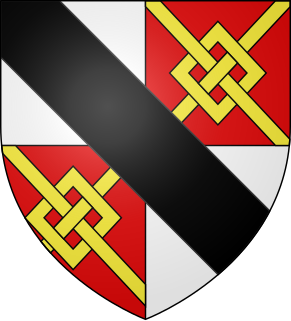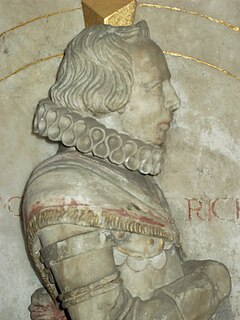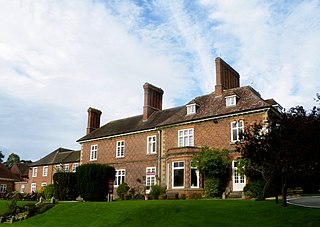
Newport is a constituent market town in Telford and Wrekin in Shropshire, England. It lies 6 miles north of Telford and 12 mi (19 km) west of Stafford, and is near the Shropshire-Staffordshire border. The 2001 census recorded 10,814 people living in the town's parish, By the 2011 census, the population had risen to 11,387.

William Longespée, 3rd Earl of Salisbury was an Anglo-Norman nobleman, primarily remembered for his command of the English forces at the Battle of Damme and for remaining loyal to his half-brother, King John. His nickname "Longespée" is generally taken as a reference to his great physical height and the oversize weapons that he used.

Roger Mortimer, 1st Baron Mortimer of Wigmore, of Wigmore Castle in Herefordshire, was a marcher lord who was a loyal ally of King Henry III of England and at times an enemy, at times an ally, of Llywelyn ap Gruffudd, Prince of Wales.

Sir Hugh le Despenser was a wealthy landowner in the East Midlands of England, and served as High Sheriff of Berkshire. Among his descendants were the infamous Despensers who became favourites of King Edward II.

Edmund Mortimer, 2nd Baron Mortimer of Wigmore was the second son and eventual heir of Roger Mortimer, 1st Baron Mortimer of Wigmore. His mother was Maud de Braose.
Humphrey Kynaston, aka Wild Humphrey Kynaston, was an English highwayman who operated in the Shropshire area. The son of the High Sheriff of Shropshire, he was convicted of murder in 1491. After being outlawed, he moved into a cave in the area and lived a lifestyle compared to Robin Hood.

Philip Henry was an English Nonconformist clergyman and diarist. His son Matthew Henry was a notable commentator on the Bible and also a Presbyterian minister.
Robert Puleston was a brother-in-law and supporter of Owain Glyndŵr, at the time of his rebellion against King Henry IV of England in the early 15th century and afterwards.
This is a list of the sheriffs and high sheriffs of Staffordshire.
Benjamin Parry was Church of Ireland Bishop of Ossory from 27 January 1678 until his death later the same year.
John Parry was Bishop of Ossory in the Church of Ireland from 1672 until his death.
Sir Roger de Pulesdon from Puleston in Shropshire, was the son of Sir Roger de Pyvelesdon, who was commemorated by his son and namesake with a Market Cross in Newport, near the family's home. He is found recorded as Sheriff of Staffordshire and Salop in 1285.

The Puleston Cross is a Butter cross in the market town of Newport, Shropshire
Sir William Maurice was a Welsh politician who sat in the House of Commons at various times between 1593 and 1611.
The Corbet family is an English family of Anglo-Norman extraction that became one of the most powerful and richest of the landed gentry in Shropshire. They trace their ancestry to two barons found in the 1086 Domesday Book and probably derive from the Brioton and Essay region, near Sées in Normandy. The name Corbet derives from the Anglo-Norman word corb, meaning "crow", matching the modern French corbeau. Variants of the name include: Corbet, Corbett, Corbitt, Corbit, Corbetts, Corbete, Corben and possibly the variant of Corbin. It has cognates in other languages: the Spanish name Cuervo, for example, which generally means a raven or rook. The underlying derivation is from the Latin word corvus, crow. Generally it is thought to be a jocular reference to a person who was thought to resemble a crow: in hair colour, tone of voice or shape of nose. However, the Scandinavians believed that a raven on the battlefield was a beneficial omen and ensured victory.

Sir Thomas Wolryche, 1st Baronet was an English landowner and politician who sat in the House of Commons for Wenlock between 1621 and 1625. He fought in the Royalist army in the English Civil War, serving as military governor of Bridgnorth.
Roger Corbet (c.1501–1538) was an English politician and landowner of the Tudor Period. A member of the Shropshire landed gentry, he represented the Borough of Truro in the English Reformation Parliament.
The Pettiward Family were a landed family prominent in Putney and Great Finborough, Suffolk who control the Pettiward Estate in Earl's Court, London.

Albrighton Hall near Shrewsbury, Shropshire, is a house which is Grade II* listed on the National Heritage List for England. It was built in 1630 for the Ireland family and remained in this family for the next five generations until 1804. It was then the home of several notable people until 1953. In the 1990s it was converted into a hotel.
Sir Henry de Verdun (I) was recorded as being a Knight of Staffordshire in 1227 and 1228, and Sheriff of Staffordshire and Coroner there in 1228, seemingly in succession to Henry de Deneston.